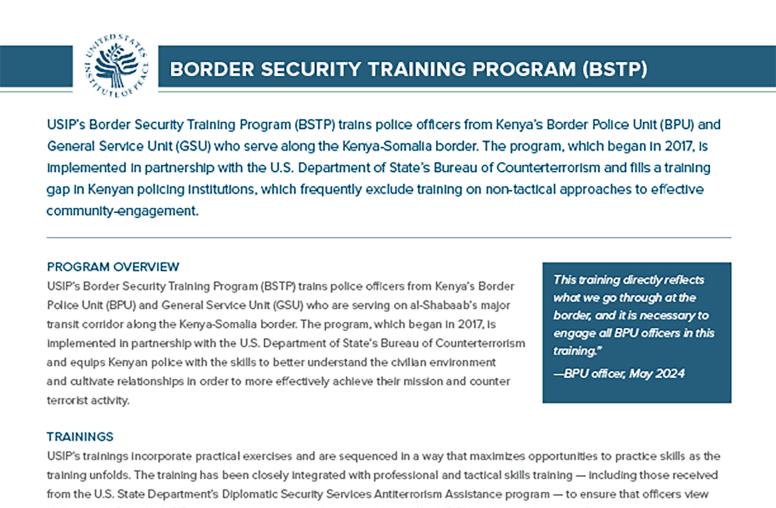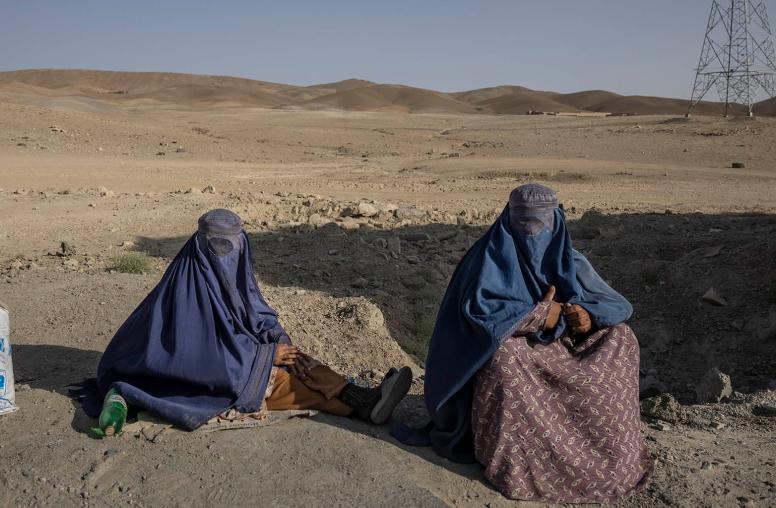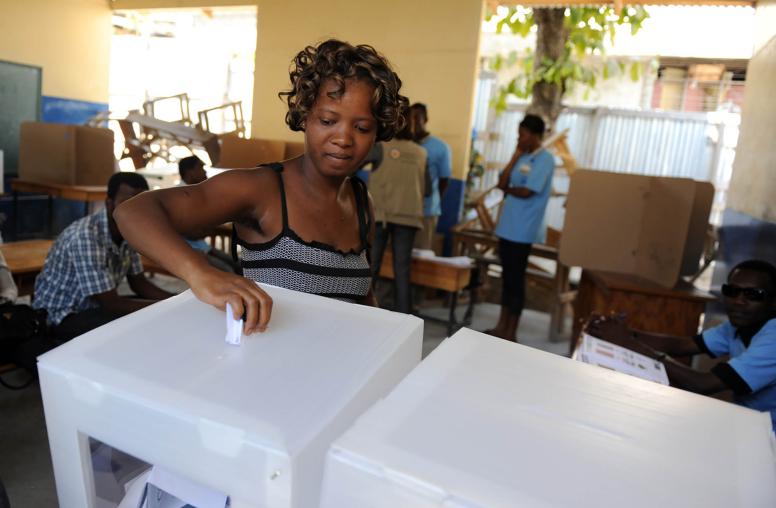To Build Peace, Boost the Women Who Lead the Movements
In crises worldwide, women are leading citizens’ campaigns that can resolve conflicts.
Images of this year’s grassroots movements for social and political change—such as the ouster of authoritarian rulers in Sudan and Algeria—reiterate that women worldwide are driving campaigns that can strengthen democracy and reduce violent conflicts. Yet 20 years after the United Nations proclaimed the need for women at the center of the world’s peacebuilding and stabilization efforts, they remain marginalized in those official processes. So when USIP and a program at the University of Denver organized a training initiative this summer for 14 women leading civic movements for social change, a message glared from the mountain of nominations received from experts and groups working on the world’s violent crises.

“Our jaws dropped at the number of nominations we received—572 from around the world—for women with exceptional credentials,” said Marie Berry, a Denver professor who co-founded the training effort. “I was reading the nominations and thinking, ‘My God, let’s put to rest forever the lazy trope that there are not enough capable, courageous women to take on leadership roles’” in resolving conflicts, strengthening civil societies and building peace. From the hundreds of candidates, Berry and colleagues from USIP selected the handful of women, from 13 countries facing problems of violent conflict, for a week of intensive work, including training, on better ways to build movements for peaceful change.
The project is shaped partly by a disconnect in the world’s efforts to manage its conflicts nonviolently. At the grass roots, women are central, driving those efforts through nonviolent campaigns. Women-led movements recently have seized public agendas in Spain, Argentina, Brazil, South Korea, India and elsewhere. Over a decade in countries facing warfare, women have organized more nonviolent campaigns for peace agreements than any other group.
Yet women remain scant in the world’s formal peacemaking institutions—the official delegations, committees and negotiating sessions of governments or the United Nations. Pressed by civil societies worldwide, the United Nations took a conceptual stride forward in 2000 with a U.N. Security Council resolution that set a first global goal for including women in peace processes. A decade later, a U.N. study found that, still, “women represent a strikingly low number of negotiators,” about 4 percent, “and that there has been little appreciable increase.” Nonetheless, U.N. and other research shows that where women are able to achieve influence, rather than a token presence, they make peace processes and peace agreements more effective and sustainable.
For all the leadership exerted by women in civil society activism, few programs focus specifically on helping women shape and lead nonviolent campaigns. And civil society activists in general face increased governmental restrictions in many countries, notably those facing violent political crises.
Strategic Choices: Women and ‘Nonviolent Action’
So in Denver, “a small group of us—philanthropists, researchers and people interested in women’s leadership—met four years ago,” Berry recalled. They noted “that there is a lot of focus on women, peace and security, but so much of that conversation is focused on elite and highly institutionalized spaces—for example, peace negotiations, politics and governance, the military.” The group made a strategic choice to focus training and support where women are energized to use them, “from the bottom up and in grassroots spaces, in places that are affected by violence and conflict.”
The result is the Inclusive Global Leadership Initiative, a program founded by the University of Denver’s Sié Center for International Security and Diplomacy. The initiative co-sponsored this summer’s session, called the Summer Institute, with USIP. Women from crisis zones as disparate as Syria, Sri Lanka, South Sudan and Nicaragua, gathered first in Colorado and then in Washington to share their discoveries in leading citizens’ movements.
“These women, aged from 20 to 60, all overcame social barriers to become leaders—an achievement that helps them lead inclusively and effectively,” said USIP’s Kathleen Kuehnast, who leads USIP’s work to promote women’s roles. “Simply gathering them to tell their stories illuminated the common challenges that women face and powerful lessons for tackling them.” She added: “Changing the ways we handle conflict and violence is more than just following a recipe that says, ‘add women and stir.’ It’s an overhaul of our processes—something deeper than most people envision. We’ve developed a framework for this that includes, as one example, our need to change how our societies define masculinity. That idea often comes as a surprise at first, even for women leaders like these.”
A further strategic choice was to train women leaders in the building of citizens’ nonviolent movements for political change. Data on major political struggles since 1900 show that that nonviolent campaigns succeed about twice as often as violent ones, according to research by USIP’s Maria J. Stephan and Harvard University professor Erica Chenoweth, previously at the University of Denver.
“Policymakers and others ask ‘Why movements? Why support and amplify the work of grassroots activists and organizers?’” Stephan said. “And people ask all the time, ‘Can these movements in violent or repressive contexts really work?’ The answers are as close as the headlines—from Sudan or Algeria today, or from Tunisia or South Africa or the U.S. civil rights movement in the past. A strategic nonviolent campaign—the kind that gathers mass, diverse participation and uses innovative tactics—disrupts unjust systems and achieves sustainable peace better than a violent one. And it does so at vastly less cost to the people involved and to the world.”
During the week’s sessions, the women strategized on building a global network through which campaign organizers like themselves can share analysis, tactics and support. They practiced exercises to show how dialogue and direct action can be used together. They worked with staff at the National Museum of African-American History and Culture to compare their experiences with that of the greatest historical U.S. example of combined peacebuilding and nonviolent action—the Civil Rights Movement. “It would undervalue this experience to call it simply a training project,” said Stephan. “This was not the University of Denver or USIP explaining how to run a movement for change. The women were learning enormously from each other.”
Nicaragua and South Sudan
The focus on nonviolent citizens’ campaigns promoted by the training is vital in crises such as the current upheaval in Nicaragua, said Alexa Zamora, who coordinates the National Youth Platform, a Nicaraguan organization that supports local programs for youth and community development. Amid Nicaragua’s turmoil, which has included a violent government crackdown on protesters, Zamora has trained civic activists on human rights protection and nonviolent methods of campaigning for change. “I began to learn about nonviolent action last year” as the clashes between protesters and the government began, Zamora said. “I am including it in training a diverse group of people. They can be student leaders, people involved in local social movements. … In Nicaragua, this is easier to teach to younger people because our older generation was trained in violent conflicts” that the country suffered in the 1980s.
Aluel Atem, a leader from South Sudan, found resonance in the training’s blending of women’s rights campaigns and conflict management techniques. Amid South Sudan’s civil war, with its pattern of attacks on women, Atem founded an organization to promote respect for women and oppose gender-based violence. Where local traditions and attitudes resist changes such as the equal roles in society that women activists seek, she said, she has found that the idea sometimes is better delivered indirectly by focusing instead on resolving local conflicts.
“I was providing training on conflict management in Torit,” a district about 80 miles southeast of Juba, the capital, Atem said, “and one of the traditional chiefs came to me and said, ‘You know, we have had people come and tell us we need to ‘empower women,’ and this has been difficult to understand. But it is a different thing to see a woman who is using her education and knowledge to help the community. Now, if someone asks me if it is important to send girls to school, I can tell them, yes, because I have seen in your work what a woman can do with her education.’ In that moment, I had not directly tried to teach anything about gender issues, but the simple fact that a woman was sharing something that he thought was valuable, for him that was powerful. It changed his mindset.”
For Berry, a central message of the training is that the world is only touching the surface of a deep, still-hidden pool of human resources for building more democratic, peaceful, productive societies. “As the international community, as policymakers, as people trying to bring peace, we miss so much of the knowledge, intelligence, experience that women have because they are not on the covers of newspapers.” Discovering these women and connecting them to each other, she says, can provide “an additional power source” for changes the world needs.





